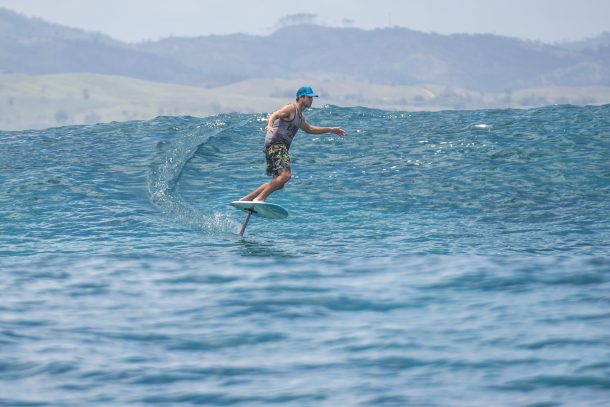Foilsurfing Q & A

Foilsurfing Q & A
We just saw this picture of REAL teamrider Jason Slezak (Slezy), shot by @JoliPhoto off Namotu, Fiji and had to check in to get the details. We realize that we have kite foilers, as well as surfers who have never kited or foiled all listening, so we based our questions off of common questions we’ve heard every day since Kai Lenny released his foil surfing footage a few months ago. Here’s what we learned. Stay tuned for more info as it becomes available.
Did he tow or paddle in?
Slezy towed into this wave and then rode it for between one and two minutes on each ride. Several other kiters and surfers who were staying on Namotu also accomplished minute plus rides.
What’s the gear he is using?
Pictured is the standard Liquid Force 4’10 Happy Pill foilboard with a short mast and a prototype low aspect surf foil designed by Ken Hardley and Chris Gutzeit @PelicanSurfFoils to create more lift at lower speeds.
Can you paddle in on the standard Liquid Force 4’10 Happy Pill foilboard?
The 4’10 Happy Pill foilboard is a really short board. The short length makes foil placement nose to tail really critical to get the balance right when paddling and standing up. In perfect conditions he can do it, but with short, steep drops the margin of error is really slim. Upping the size of the board will make this a lot easier, but Slezy didn’t have the time to source a larger foil specific surfboard before the trip.
Can you surf like this on a standard Liquid Force foil?
This question is focused on the actual foil, that being the wing that is underwater. The Liquid Force foils are higher aspect foils that reach peak efficiency at higher speeds. They work perfectly with a kite, but lack the lift at lower speeds needed to be efficient for foil surfing without the kite. When Slezy and the crew used the standard LF foils, they were able to stay on foil (in the air) while riding a wave, but were not able to keep going when the wave was not there anymore. The lower aspect prototype foil was better at connecting waves and also staying on foil with no wave at all once it had momentum.
What do you do at the end of the wave?
With the lower aspect prototype foil you can pump the board and stay on foil on your way out until you catch the next wave. For this, it will help to have a channel, or to be riding in a place where the wave actually never breaks. With the higher aspect kite specific foils, once the wave is done your ride is done and you will need to paddle back out or get a ride on a ski. The pumping motion mentioned above requires good leg conditioning, so people like Kai and Slezy can pump a lot further that most, but once you build up that skill set (and muscles) it will come easier (like riding powder).
What’s the learning curve?
When you look at this picture and think about doing it yourself, you immediately flash to the picture of the guy who took the foil to the face and think only Kai Lenny can do this. Slezy has a ton of kitesurfing foil experience, but this was his first time trying to surf one and he said, with his prior kitesurfing foil experience, it was relatively easy. Basically he said all the REAL crew, or people who kite foil at that level, would be able to go out and foil surf tomorrow with access to the right gear and conditions. For those that have no kitesurfing experience on a foilboard, you can learn to foil behind a jetski or a boat in a few hours. If you’re in Cape Hatteras, this is something we teach at REAL behind our skis every day. On Namotu, some of the surfing guests learned behind skis and were following Slezy into the waves after a few hours. Slezy pointed out, if you can master foiling behind a ski, boat or kite BEFORE you try foil surfing in the waves, it will make it significantly easier to learn.
Can you buy this gear?
Yes? No? Maybe?…at least not all of it yet. Just like the beginning of kitesurfing, and then foilboarding, the gear is being hand made one at a time, and it’s getting better every version. Most of the custom foil manufacturing capacity is currently being sucked up by SUP foiling demand as well as high-end kite racing foils. Slezy mentioned several times that the more time you spend on the foil, be it behind a kite, a boat, a ski or even in a cable park, the more easily you will get the hang of foilsurfing the first time. So for that part of the equation, the stock Liquid Force foil gear works perfectly and is readily available. Also, for those that already own this gear, they can start practicing behind a ski getting whipped into gentle breaking or non-breaking waves. For the lower aspect surf specific foils, you will have to wait for prototypes to become production and available to the public.
If you were stranded on a desert island, with only access to stock gear, what would you use?
Slezy said the best combo of stock gear would be the lower aspect Liquid Force Foilfish foil, with the long fuselage and short mast. Attaching this to a floatier board would enable you to paddle into waves. Using the stock Liquid Force foilboards (which are lower in volume) pushes you more in the direction of needing to tow in, which is still fun.
Where will people use this new foil surfing set up and why is it so exciting?
First off, don’t get haired out this is coming to your homebreak and will be the next coming of SUPS stealing all the set waves. Best place to maximize the potential of this new avenue of the surfing is on waves that NOBODY is surfing right now. This includes waves that never break and wouldn’t even be on your list for normal surfing. Get away from the crowds. There’s a lot of open rolling waves out there that will turn this new sport into summertime powder surfing.
Jason Slezak, our original teamrider, has been sponsored by REAL since 2001. Jason is also sponsored by Liquid Force, Patagonia, POC Sports and Stoked Roasters.

